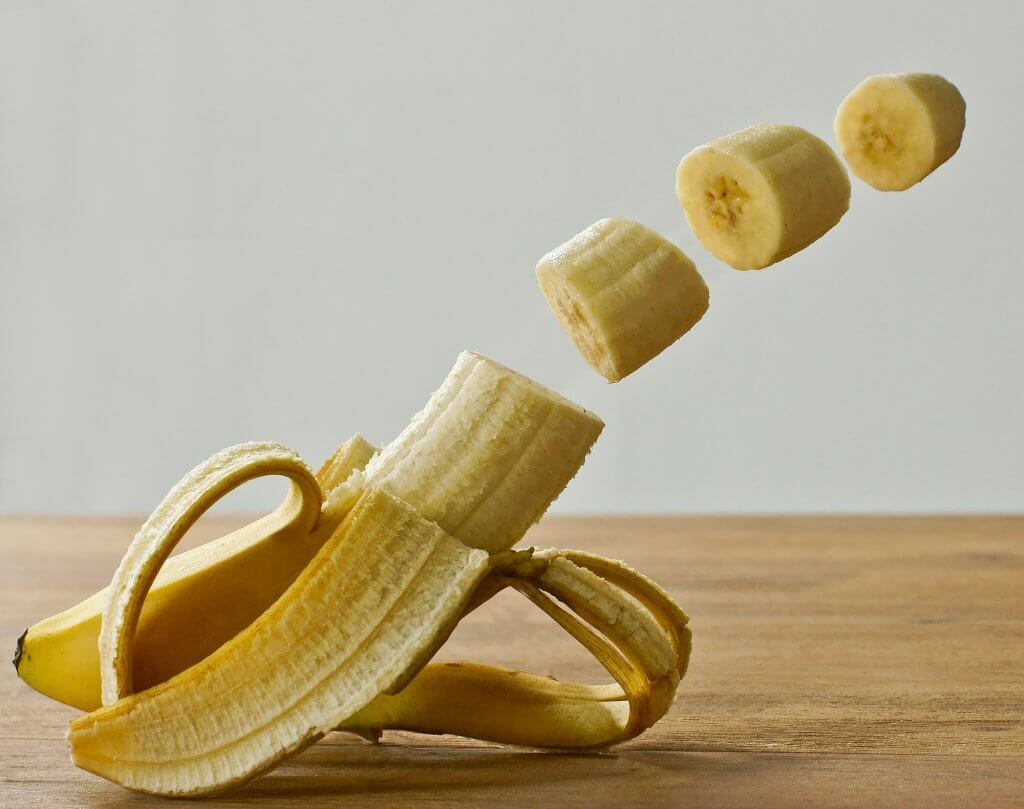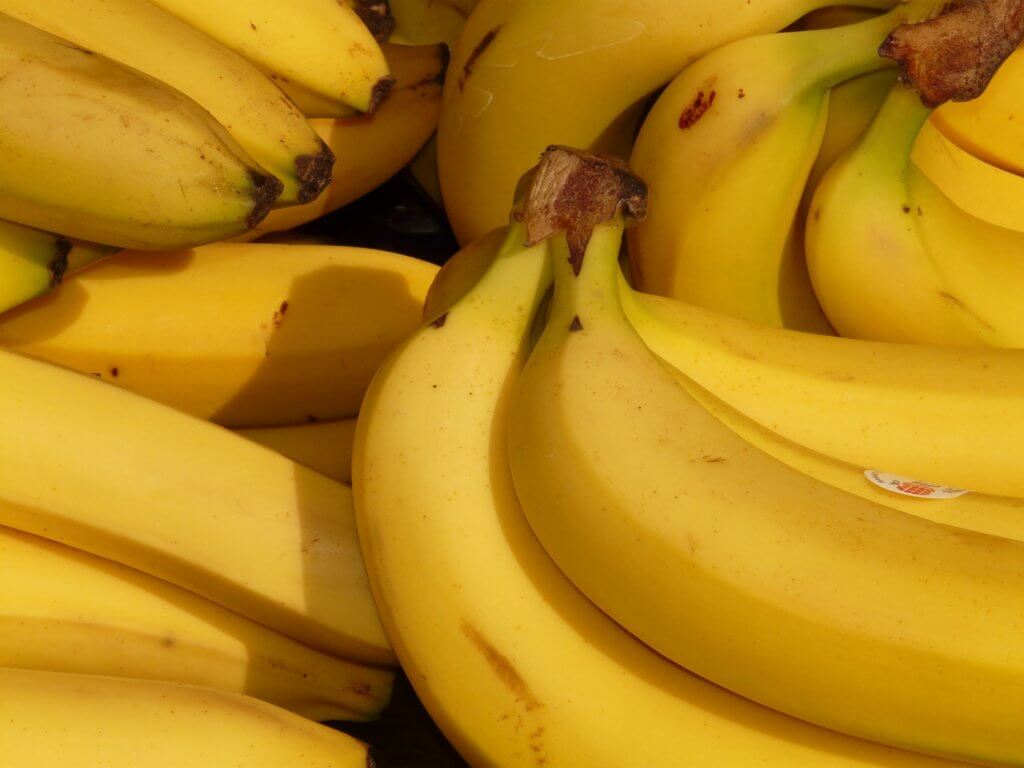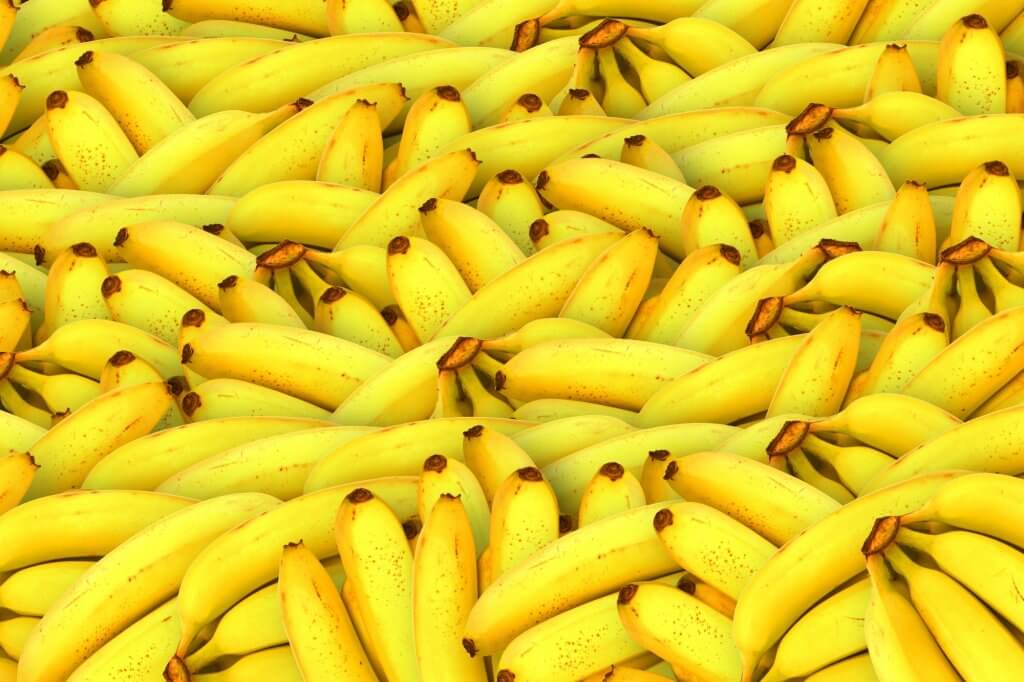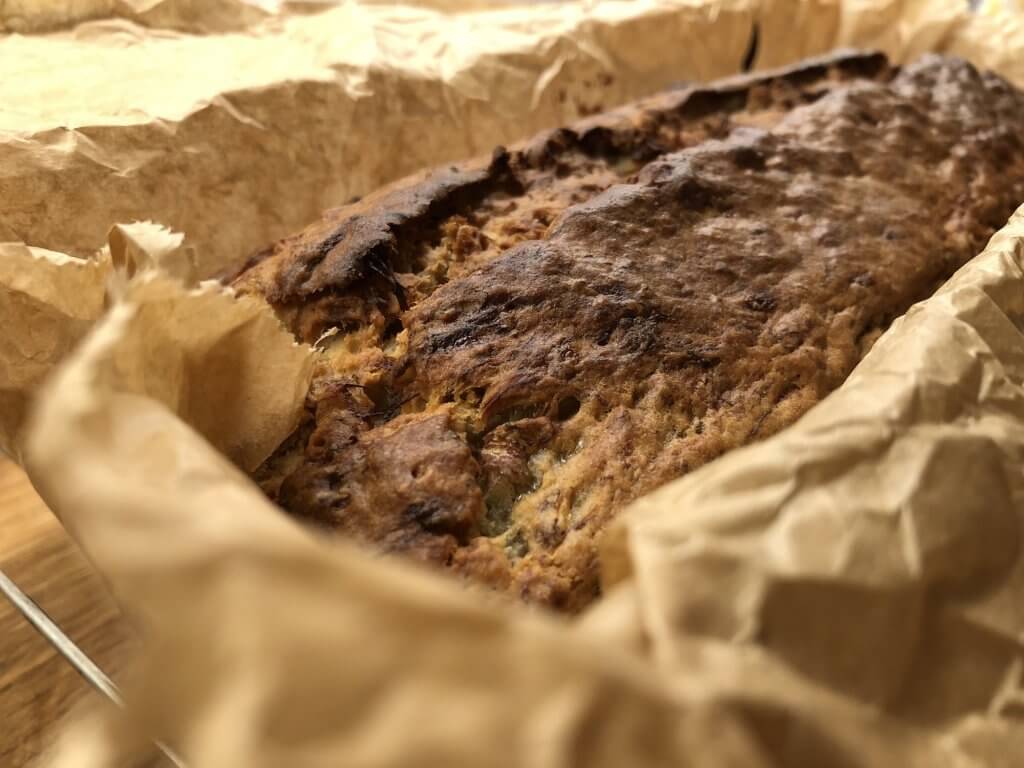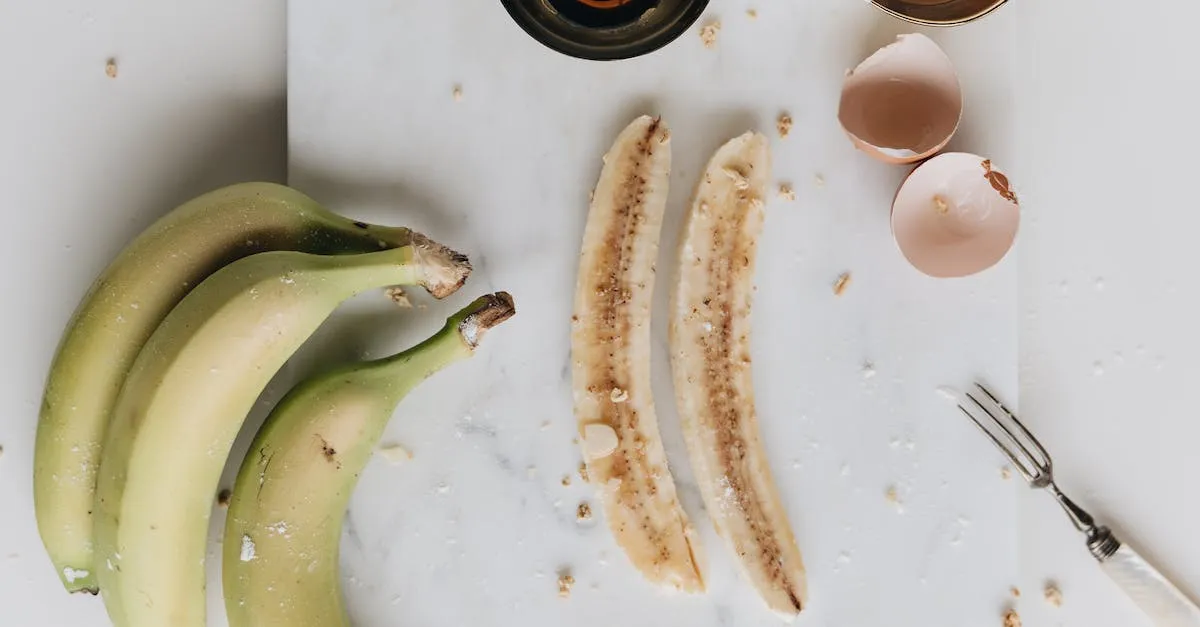
Are you in the middle of baking a delicious recipe only to realize that you’re out of bananas? Don’t worry, we’ve got you covered! In this article, we’ll show you some quick and easy ways to replace a banana in your recipe without compromising on taste or texture. Whether you’re looking for a healthier alternative or simply need a substitute due to allergies or dietary restrictions, we’ve got a solution for you. So, let’s dive in and discover how you can keep your recipe on track, even without a banana!
You may be wondering, why would I need to replace a banana in a recipe? Well, there could be several reasons. Perhaps you’re trying to cut back on sugar or calories and want to explore healthier options. Or maybe you or someone you’re baking for has a banana allergy or sensitivity. Whatever the reason, it’s important to know that there are plenty of alternatives that can give you similar results. In this article, we’ll explore some popular substitutes that you can easily find in your kitchen or local grocery store. So, let’s get started and find the perfect replacement for your banana!
The Importance of Substitutions in Recipes

When it comes to cooking and baking, sometimes you find yourself in a situation where you need to replace an ingredient. This could be due to dietary restrictions, allergies, or simply because you don’t have the ingredient on hand. Whatever the reason may be, substitutions are an essential skill to have in the kitchen.
Why are substitutions important?
- Flexibility: Substitutions allow you to be more flexible with your recipes. You don’t have to be limited by the ingredients listed; instead, you can experiment and adapt to your preferences and dietary needs.
- Allergies and dietary restrictions: Many people have food allergies or follow specific diets that require them to avoid certain ingredients. Substituting ingredients allows them to still enjoy their favorite recipes without compromising their health.
- Availability: Sometimes you want to make a recipe, but you don’t have all the ingredients on hand. Instead of running to the store, you can find suitable substitutes in your pantry or fridge.
- Variety: Substitutions can add variety to your cooking. By trying different ingredients, you can discover new flavors and textures that can enhance your dishes in unique and exciting ways.
How to approach substitutions
- Research: Before substituting an ingredient, it’s important to do a little research. Understand the role the ingredient plays in the recipe and find a suitable replacement that will maintain the desired taste and texture.
- Consider flavor profiles: When substituting, consider the flavor profiles of the original ingredient and the potential substitute. Look for ingredients that have similar taste characteristics to ensure the substitution doesn’t drastically alter the overall flavor of your dish.
- Experiment: Don’t be afraid to experiment with substitutions. Cooking is all about creativity and trying new things. Keep track of your substitutions and their outcomes so you can learn from your experiences and improve your cooking skills.
- Gradual changes: If you’re unsure about a substitution, try making gradual changes. Start by replacing a small portion of the ingredient and see how it affects the recipe. This way, you can adjust and fine-tune until you achieve the desired result.
Remember, substitutions are all about adapting and making the most out of the ingredients you have. With a little creativity and experimentation, you can create delicious dishes that suit your needs and preferences. So don’t be afraid to step out of your comfort zone and explore the world of substitutions in your recipes.
Why Replace a Banana?
As an expert on bananas, I understand that sometimes you may find yourself in a situation where you need to replace this beloved fruit in a recipe. Whether it’s due to a dietary restriction, an allergy, or simply not having any bananas on hand, there are plenty of reasons why you might need to find a suitable substitute.
1. Accommodating Dietary Restrictions and Allergies
One of the most common reasons for replacing a banana in a recipe is to accommodate dietary restrictions or allergies. While bananas are a great source of nutrients and fiber, some people may have allergies or intolerances to them. In such cases, it’s important to find alternatives that can still provide similar taste, texture, and nutritional benefits.
2. Availability of Ingredients
Another reason to replace a banana in a recipe is the availability of ingredients. Perhaps you’re in the middle of baking and realize that you’ve run out of bananas. Instead of running to the store or abandoning the recipe altogether, knowing suitable substitutions can save the day. It’s always handy to have a few alternatives up your sleeve.
3. Adding Variety to Your Cooking

Lastly, replacing a banana in a recipe can be a great way to add variety to your cooking. While bananas are delicious and versatile, sometimes you may want to switch things up and try something new. By exploring different substitutions, you can discover unique flavors and textures that can bring a fresh twist to your dishes.
Remember, when it comes to replacing a banana in a recipe, it’s important to consider the role of the banana in the dish. Is it providing moisture, sweetness, or acting as a binding agent? Understanding the purpose of the ingredient will help you choose the most suitable substitute.
So, whether you’re looking to accommodate dietary restrictions, deal with ingredient availability, or simply add variety to your cooking, there are plenty of reasons why you might need to replace a banana in a recipe. Stay tuned for the next section where we will dive into some delicious alternatives to bananas that you can use in your favorite recipes.
Popular Banana Substitutes
If you find yourself in a situation where you need to replace a banana in a recipe, fret not! There are several common substitutes that can provide a similar texture and flavor to your dish. Let’s explore some popular banana substitutes that you can try out in your recipes:
1. Plantains
Plantains are a great option if you’re looking for a substitute with a similar taste and texture to bananas. These starchy fruits are slightly larger and firmer than bananas, but they can be used in both sweet and savory dishes. When using plantains as a substitute, make sure to choose ripe ones for a sweeter flavor or green ones for a more starchy taste.
2. Applesauce
Applesauce is another versatile substitute that works well in many recipes. It can add moisture and sweetness to your dish, just like bananas. When using applesauce as a substitute, use the same amount as you would for mashed bananas. Keep in mind that applesauce might alter the flavor profile slightly, so consider the compatibility with the other ingredients in your recipe.

3. Greek Yogurt
« How to Make Moist Banana Bread with Oil
The Ultimate Guide to Creating a Delicious Banana Cake »
Greek yogurt is a healthy and creamy alternative to bananas. It can add moisture and a tangy flavor to your recipe. When substituting with Greek yogurt, use the same amount as you would for mashed bananas. If you’re concerned about the lack of sweetness, you can add a touch of honey or maple syrup to balance the flavors.
4. Silken Tofu
For those following a vegan or dairy-free diet, silken tofu can be an excellent substitute for bananas. It has a creamy texture and can provide moisture to your dish. When using silken tofu, blend it until smooth before adding it to your recipe. Use the same amount as you would for mashed bananas.
Remember, when substituting bananas in a recipe, it’s important to consider the role the bananas play in the dish. If bananas provide sweetness or moisture, choose a substitute that can replicate those qualities. And don’t be afraid to experiment! Substitutions can lead to exciting and delicious discoveries in the kitchen.
1. Applesauce
If you’re looking for a versatile and healthy substitute for bananas in your recipes, applesauce is a fantastic option. Not only does it add moisture and a touch of sweetness to your dishes, but it also provides a similar texture to mashed bananas.
When using applesauce as a substitute, keep in mind that it works best in recipes that call for mashed or pureed bananas. It’s a great choice for baked goods like muffins, cakes, and breads.
To replace a banana with applesauce, use a 1:1 ratio. For example, if your recipe calls for one mashed banana, you can substitute it with one-fourth cup of applesauce. This will ensure that your baked goods have the right amount of moisture and flavor.
One of the advantages of using applesauce as a substitute is that it’s naturally sweet, so you may need to reduce the amount of added sugar in your recipe. Keep in mind that the sweetness of the applesauce can vary, so adjust the amount of sugar according to your taste preferences.
When using applesauce, it’s also important to consider the flavor profile. While bananas have a distinct flavor, applesauce has a milder taste. However, it pairs well with spices like cinnamon, nutmeg, and vanilla, enhancing the overall flavor of your dishes.
If you prefer a chunkier texture in your baked goods, you can use homemade applesauce with small apple chunks. This will add a delightful texture and bursts of apple flavor to your recipes.
2. Yogurt

When it comes to substituting bananas in your recipes, yogurt can be a fantastic option. Not only does it provide a similar texture to mashed bananas, but it also adds a creamy and tangy flavor to your dishes. Whether you’re making smoothies, baked goods, or even pancakes, yogurt can work wonders as a banana replacement.
One of the great things about using yogurt as a substitute is its versatility. You can choose from a variety of options such as Greek yogurt or plain yogurt depending on your preferences and the recipe you’re working with. Greek yogurt, in particular, has a thicker consistency which can mimic the thickness of mashed bananas more closely.
When using yogurt as a replacement, keep in mind that bananas add moisture and sweetness to your recipes. To compensate for the moisture, you may need to reduce the amount of liquid in your recipe slightly. Additionally, you might want to adjust the amount of added sugar to maintain the desired level of sweetness.
Consider the flavor profile of your dish when using yogurt as a substitute. While bananas have a distinct flavor, yogurt can bring a tangy taste to the table. This can work well in certain recipes, such as smoothies or muffins, where the tanginess can complement other ingredients. However, in recipes where the banana flavor is more prominent, you may need to experiment with additional flavorings to achieve the desired taste.
If you’re feeling adventurous, you can even try combining yogurt with other banana substitutes, such as applesauce or silken tofu, to create a unique and delicious flavor profile in your recipes. The possibilities are endless when it comes to experimenting in the kitchen!
3. Pumpkin Puree

If you’re looking for a unique and flavorful substitute for bananas in your recipes, pumpkin puree is a fantastic option. With its creamy texture and slightly sweet taste, pumpkin puree can add depth and richness to your dishes. Plus, it’s packed with vitamins and nutrients, making it a healthy choice as well.
Why choose pumpkin puree?
1. Similar texture: Pumpkin puree has a smooth and creamy texture, similar to mashed bananas. This makes it a great substitute when you want to maintain the same consistency in your recipe.
2. Rich flavor: Pumpkin puree has a naturally sweet and earthy flavor that can complement a variety of dishes. It adds a subtle hint of pumpkin to your recipes, which can be especially delicious in baked goods like muffins, breads, and cakes.
3. Nutritional benefits: Pumpkin puree is a nutritional powerhouse. It’s high in fiber, vitamin A, and antioxidants, making it a healthy addition to your recipes. Plus, it’s low in calories and fat, making it a great option for those watching their waistline.
How to use pumpkin puree as a substitute?
When substituting bananas with pumpkin puree, keep in mind the following tips:

1. Adjust the sweetness: Since pumpkin puree is not as sweet as bananas, you may need to adjust the amount of added sugar in your recipe. Taste the batter or dough as you go and add more sugar if needed.
2. Consider the flavor profile: Pumpkin puree has a distinct flavor, so it’s important to consider how it will complement the other ingredients in your recipe. It pairs well with warm spices like cinnamon, nutmeg, and cloves. Experiment with different flavor combinations to find what works best for you.
3. Combine with other substitutes: For a truly unique flavor profile, consider combining pumpkin puree with other banana substitutes like applesauce or Greek yogurt. This can create a well-rounded taste and add even more moisture to your recipe.
4. Chia Seeds
If you’re looking for a unique and healthy substitute for bananas in your recipes, chia seeds are a fantastic option. These tiny superfoods are packed with nutrients and can add a great texture to your dishes. Here’s why chia seeds make a great banana substitute and how you can use them in your recipes.
Why Chia Seeds?

Chia seeds are known for their ability to absorb liquid and develop a gel-like texture. This makes them an excellent substitute for bananas, as they can provide moisture and binding properties to your recipes. Additionally, chia seeds are rich in omega-3 fatty acids, fiber, and antioxidants, making them a nutritious addition to your meals.
Using Chia Seeds as a Substitute
To use chia seeds as a substitute for bananas, you’ll need to create a chia gel. Simply mix 1 tablespoon of chia seeds with 3 tablespoons of water and let it sit for about 15 minutes until it thickens. This gel can then be used as a replacement for one mashed banana in your recipe.
Tips for Using Chia Seeds
- Adjust the sweetness: Since chia seeds don’t have the natural sweetness of bananas, you may need to add some sweetness to your recipe. Consider adding a bit of honey, maple syrup, or your preferred sweetener to achieve the desired taste.
- Consider the flavor profile: Chia seeds have a mild and nutty flavor that can complement a variety of dishes. However, keep in mind that their flavor may not be as pronounced as bananas. Consider pairing chia seeds with ingredients that will enhance their taste, such as cinnamon, vanilla, or almond extract.
- Combine with other substitutes: For a unique flavor profile, consider combining chia seeds with other banana substitutes mentioned earlier. You can experiment with using chia gel along with applesauce, Greek yogurt, or pumpkin puree to create a delicious and nutritious alternative.
Incorporating chia seeds as a banana substitute in your recipes not only adds a twist to your dishes but also provides you with the nutritional benefits of these amazing seeds. So, don’t hesitate to get creative in the kitchen and explore the versatility of chia seeds.
5. Silken Tofu

If you’re looking for a substitute for bananas that can add a creamy texture to your recipes, consider using silken tofu. Silken tofu is a versatile ingredient that can be used in both sweet and savory dishes. It has a mild flavor and a smooth, silky texture, making it a great option for replacing bananas in recipes.
One of the key benefits of using silken tofu as a banana substitute is its ability to provide moisture and binding properties. Just like bananas, silken tofu can add moisture to baked goods and help bind the ingredients together. This is especially useful in recipes like muffins, cakes, and breads where bananas are used to add moisture and structure.
To use silken tofu as a substitute for bananas, simply puree the tofu until smooth and creamy. You can then use it in the same quantities as you would use mashed bananas in your recipe. Keep in mind that silken tofu has a higher water content than bananas, so you may need to adjust the other liquid ingredients in your recipe accordingly.
In addition to its texture and binding properties, silken tofu is also a nutritious alternative to bananas. It is a good source of protein, calcium, and iron, making it a great option for those looking to add more nutrients to their recipes.
To enhance the flavor of silken tofu and make it more similar to bananas, you can add a touch of vanilla extract or a sprinkle of cinnamon to your recipe. This will help mimic the sweet and slightly fruity flavor of bananas.
Tips for Successful Banana Substitutes

If you’re looking to replace bananas in a recipe, whether it’s due to allergies, dietary restrictions, or simply because you don’t have any on hand, there are plenty of options available to you. Here are some tips to ensure that your banana substitutes are successful:
1. Understand the role of bananas in the recipe: Before choosing a substitute, it’s important to understand what bananas bring to the dish. Are they adding moisture, sweetness, or binding properties? Knowing this will help you choose a suitable replacement.
2. Consider flavor profiles: Bananas have a distinct flavor, so when choosing a substitute, consider how it will complement or enhance the other ingredients in the recipe. Some substitutes, like applesauce or Greek yogurt, have a similar sweet and tangy flavor, while others, like silken tofu or pumpkin puree, have a more neutral taste.
3. Experiment with different substitutes: Don’t be afraid to get creative in the kitchen! Try different substitutes in your recipes to see which ones work best for you. Each substitute will bring its own unique texture and flavor, so have fun exploring and finding new favorites.
4. Make gradual changes: If you’re hesitant about completely replacing bananas, start by making gradual changes. For example, you could substitute half of the bananas with another ingredient and see how it affects the final result. This way, you can gradually transition to using a different substitute if you prefer.

5. Adjust other liquid ingredients: When using a substitute for bananas, you may need to adjust the other liquid ingredients in the recipe. Some substitutes, like silken tofu, may require a bit more moisture to achieve the desired consistency. Be sure to make any necessary adjustments to ensure a successful outcome.
Remember, the goal of substituting bananas in a recipe is not only to accommodate dietary needs or preferences, but also to add variety and nutrition to your cooking. Embrace the opportunity to try something new and discover the delicious possibilities that lie beyond bananas.
Next, we’ll dive deeper into using silken tofu as a substitute for bananas. This versatile ingredient not only provides moisture and binding properties, but also offers nutritional benefits. Let’s explore how to use silken tofu as a banana substitute in your recipes.
Conclusion
In this article, we have explored the importance of substitutions in recipes and provided helpful tips on how to approach them. By being open to substitutions, you can accommodate allergies and dietary restrictions, make use of available ingredients, and add exciting variety to your cooking.
We specifically focused on popular banana substitutes such as plantains, applesauce, Greek yogurt, silken tofu, pumpkin puree, and chia seeds. These alternatives share similar textures and flavor profiles, making them excellent choices when replacing bananas in your recipes.

One substitute we discussed in detail is silken tofu. Not only does it provide moisture and binding properties, but it also offers nutritional benefits. To use silken tofu as a substitute, simply puree it until smooth and creamy and adjust other liquid ingredients in the recipe. You can enhance its flavor with vanilla extract or cinnamon to mimic the taste of bananas.
Remember, the key to successful substitutions is understanding the role of bananas in your dish, considering flavor profiles, experimenting with different substitutes, making gradual changes, and adjusting other liquid ingredients as needed. By incorporating banana substitutes, such as silken tofu, you can add creaminess and nutrients to your dishes while exploring new flavors.
So go ahead, embrace the world of substitutions and let your creativity shine in the kitchen. Enjoy the process of discovering new and delicious alternatives that will add variety and nutrition to your cooking. Happy substituting!







